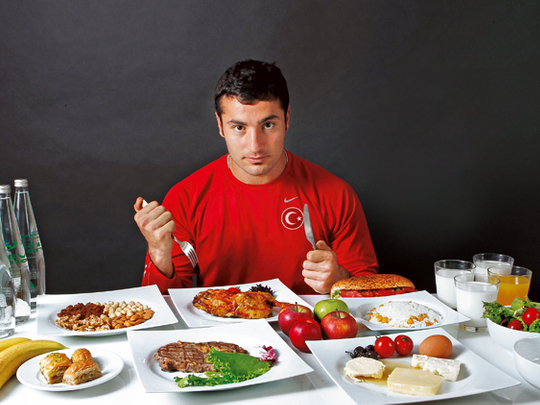
Dylan Armstrong, shot-putter, Canada
He eats between 6,500 and 9,000 calories per day. "It is easy to eat a lot of calories," Armstrong said in an interview. "I like a lot of salmon, and obviously, beef and chicken. I am on a high-protein, low-carb diet. I eat five or six times a day."
Dr Dhavjekar: "To throw a 16-pound (about 7.25kg) shot put with speed, Armstrong has to have adequate mass energy, but with age and changing metabolism, he will have to adapt his lifestyle. He has to control his beef consumption as this can induce gout. Red meat should preferably be eaten twice a week, with heavy activity to increase his metabolism."
Kargutkar: "His high calorie diet needs optimum hydration, and pre- and post-workout nutrition is a must. Eating five to six meals a day is a smart thing to do, which boosts his Basal Metabolic Rate (BMR). However, high-intensity workouts come with a lot of wear and tear to the body, so he should take antioxidants, and keep a close watch on his body fat percentage."
Garrett Weber-Gale, swimmer, USA
Weber-Gale has high blood pressure, and is co-founder of Athletic Foodie, a firm dedicated to helping people eat well.
A normal day for him means one or two bowls of wholegrain cereal with rice milk and flax seeds, almond milk with berries for a snack, dried mangoes or pineapples and a strawberry shake for training recovery, and oatmeal, almonds, peanut butter and jelly and scrambled eggs, before lunch.
Lunch is asparagus, apples, walnuts, prunes, and a veggie burger or tacos with rice and beans. After weightlifting, it is an energy bar, dry fruit and another shake, before a dinner of kale or spinach and a big salad with brown rice, millet, barley, red or kidney beans. The mostly plant-based diet is substantiated with weekly red meat and salmon to keep the haemoglobin count high. He also has dark chocolate every day. "I have worked with nutritionists to learn what to eat, when to eat, and how to get all the protein, carbohydrates, minerals, vitamins and other essential nutrients I need," he has said.
Dr Dhavjekar: "It is an ideal combination of foods to maintain control over high blood pressure."
Kargutkar: "Everyone with high blood pressure, athletes and non-athletes, should monitor their salt intake. Weber-Gale must pay heed to the quantity of flax seeds he consumes, because of the oestrogen factor. Half an hour of pranayama (yogic breathing exercise) will greatly enhance his performance."
Sarah Storey, Paralympic cyclist, UK
Storey eats protein every three hours and jam sandwiches for energy while cycling. "I can be on the saddle for six hours [a day], so what I eat is crucial.
For an event like end-to-end, where you are riding 90 to 130 miles (about 145 to 210km) a day for nine days, the fuel is not just for that day, it is also to make sure you are not in deficit the next morning. So I eat protein every three hours and have jam sandwiches passed out from the support vehicle," she has said.
Dr Dhavjekar: "As Storey cycles a lot, it is important to include whole grain carbohydrates and good sources of fat such as flax seeds, walnuts and olives in
her diet."
Kargutkar: "Eating protein every three hours helps her maintain lean body mass, but eating solids while exercising is not a great idea. Instead, fast-absorbing carbohydrates such as bananas or grapes are great for pre- and post-practice. She must also take electrolytes at regular intervals, while her water intake will depend on the intensity and duration of the practice, and the quantity and the quality of her carbohydrate, protein and fat intake."
Adam Nelson, shot-putter, USA
Nelson takes 300g of protein every day, over three-hour intervals.
His typical day includes six to eight eggs, a cup or two of berries, coffee at 6.30am, an apple and a protein shake at 9.30am, a turkey sandwich with spinach and green and red peppers, and a glass of milk for lunch, leftovers from the night before for an afternoon snack, and a kilogram of salmon with grilled vegetables and rice for dinner. Just before bed, he has yet another protein shake.
Dr Dhavjekar: "Ideally, more carbohydrates should be consumed in the morning and tapered down towards evening, while more proteins should be eaten in the evening so that the metabolism takes it right, and digestion is better. Assuming that he sleeps early and gets up at 6.30am, he should have carbohydrates latest by 7pm. For laypeople, the last major carbohydrate consumption should be by 3pm in order to maintain a healthy body."
Kargutkar: "Nelson can have a protein shake with berries early in the morning for a quick supply of energy, and casein at night for a slow release of protein. He can also easily increase his vegetable intake. As always, he must consider antioxidants and keeping his body hydrated at all times."
Tyson Gay, sprinter, USA
Gay has 230g of protein, 308g of carbohydrates and 70g of fat and legal supplements daily, in a diet that is tailor-made and monitored by a nutritionist at EAS Sports Nutrition. He eats six meals a day, consisting of everything from raisins and yoghurt, to ground turkey and fish. "It is a diet plan to really set me up to be the best I can be," he has said.
Dr Dhavjekar: "As a runner, his diet is well balanced and the only caution is fermented products. Over a certain age, metabolism has its own way of behaving and can give rise to respiratory tract disorders. For a layperson, it is important to remember that supplements are to be taken only when there is a sufficient amount of training/activity, so that they are metabolised instead of getting accumulated in the body."
Kargutkar: "Weight training is a part of every sprinter’s workout, so he should ensure a balanced protein diet and can increase protein content by 20kg to 30g. He must also keep a constant check on lean body mass and allow a gap of not more than three hours between meals. Antioxidants and hydration must form part of his diet, especially electrolytes."
Fatih Avan, javelin thrower, Turkey
Avan’s daily intake includes about four litres of water, a glass of milk, a glass of juice, large bowl of nuts, a roast chicken with salad greens, a sandwich, a steak, apples, bananas, cheese, eggs and vegetables, consumed at regular intervals during the day.
Dr Dhavjekar: "He is consuming all the required nutrients. Red meat should be in moderation, at least twice a week."
Kargutkar: "Water is an important factor and its intake can be increased to five to six litres a day for better performance. I do hope his diet is spread out over five or six meals throughout the day, and that the slow release proteins are eaten at night."
Michael Arnstein, marathon runner, USA
The Olympian hopeful grew up eating an average American diet. When he was 15, his siblings began eating a healthier diet for high school sports and he followed in their footsteps. After becoming a strict vegan at the age of 26, Arnstein now follows the 80/10/10 raw vegan diet, which means eating 80 per cent fruit and vegetables, 10 per cent protein and 10 per cent fat.
Dr Dhavjekar: "It is a perfect balance. Bananas, almonds and beetroots are super foods that help build his muscles."
Kargutkar: "Fruits and vegetables are great sources of slow release carbohydrates, which is good for any marathon runner. But muscles are the building blocks of the body and help better performance, so it is important for him to build lean body mass (LBM). Protein at 10 per cent may be on the lower side, and he may need to increase this after checking his LBM."








